The Problem: Are you struggling with procrastination and productivity? Feeling overwhelmed with too much to do, but not able to make progress on your most important goals? You’re not alone in this battle.
The Solution: “Eat That Frog!” is more than your average productivity book – it’s a proven guide to time management with over 3 million copies sold. Brian Tracy brings 30 years of research into actionable steps that help overcome procrastination. It’s perfect for anyone looking to plan better, prioritize tasks, and get more work done in less time.
The “Eat That Frog!” productivity method – 21 steps:
In our summary of Eat That Frog, we’ll explain and analyze all 21 steps of Brian Tracy’s method. Let’s begin with a fast overview of what all the steps are:
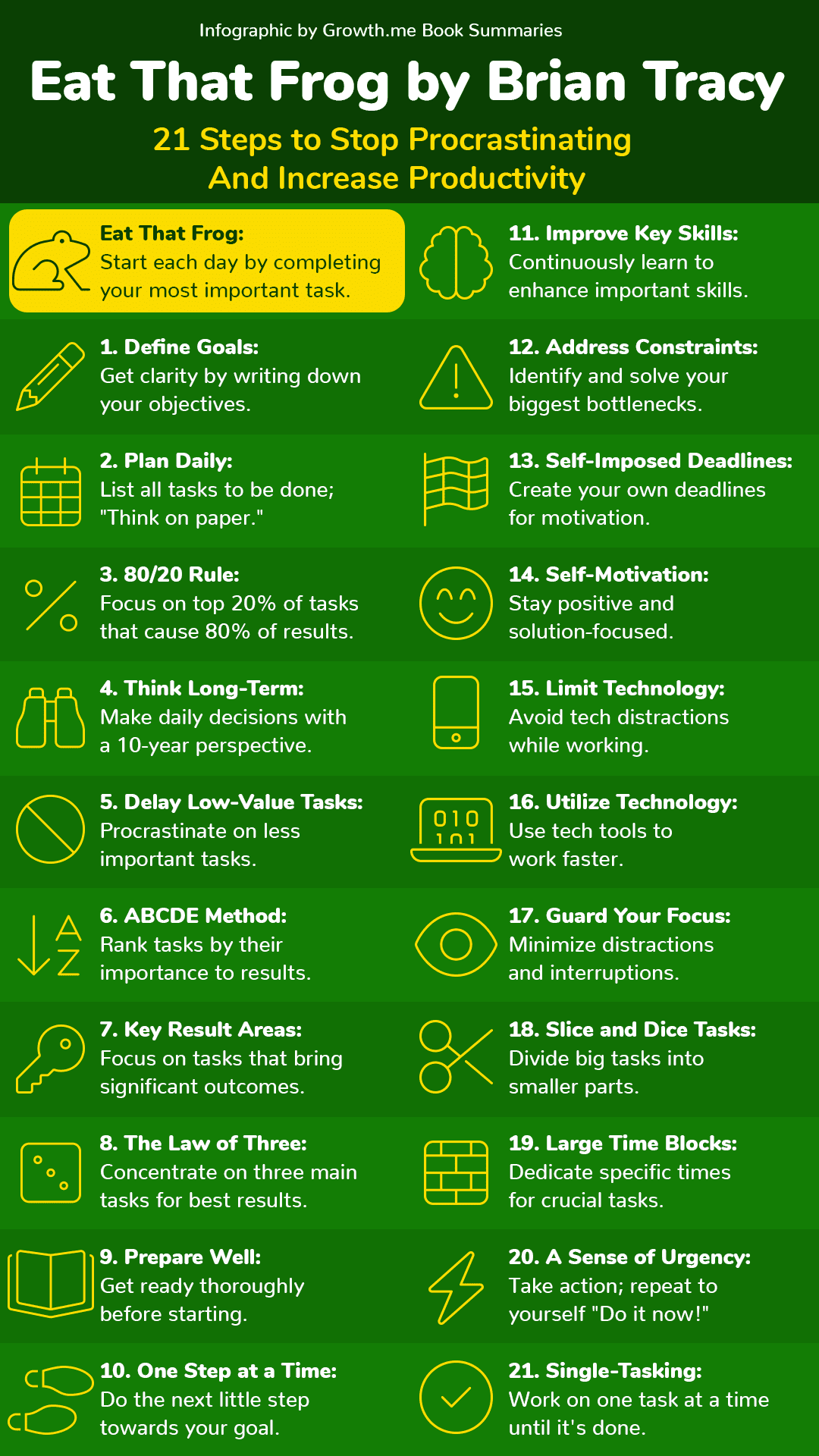
- Define Goals: Get clarity by writing down your objectives.
- Plan Daily: List all tasks to be done; “Think on paper.”
- 80/20 Rule: Focus on top 20% of tasks that cause 80% of results.
- Think Long-Term: Make daily decisions with a 10-year perspective.
- Delay Low-Value Tasks: Procrastinate on less important tasks.
- ABCDE Method: Rank tasks by their importance to results.
- Key Result Areas: Focus on tasks that bring significant outcomes.
- The Law of Three: Concentrate on three main tasks for best results.
- Prepare Well: Get ready thoroughly before starting.
- One Step at a Time: Do the next little step towards your goal.
- Improve Key Skills: Continuously learn to enhance important skills.
- Address Constraints: Identify and solve your biggest bottlenecks.
- Self-Imposed Deadlines: Create your own deadlines for motivation.
- Self-Motivation: Stay positive and solution-focused.
- Limit Technology: Avoid tech distractions while working.
- Utilize Technology: Use tech tools to work faster.
- Guard Your Focus: Minimize distractions and interruptions.
- Slice and Dice Tasks: Divide big tasks into smaller parts.
- Large Time Blocks: Dedicate specific times for crucial tasks.
- A Sense of Urgency: Take action; repeat to yourself “Do it now!”
- Single-Tasking: Work on one task at a time until it’s done.
About the author
Brian Tracy is a famous motivational speaker and author. He has spoken in over 70 countries and written more than 80 books on success, leadership, sales, and personal growth. His company, Brian Tracy International, has done training programs and consulting for more than 1,000 companies.
🐸 1. Eat That Frog: The main idea is to do the hardest thing first, every single day
Why This Matters: Ever noticed how accomplishing a tough task gives you a sense of achievement? “Eat That Frog” is based on this concept. The book encourages you to start your day by tackling your most challenging task – the one you’re most likely to procrastinate on, yet holds the greatest potential to make a positive impact in your life.
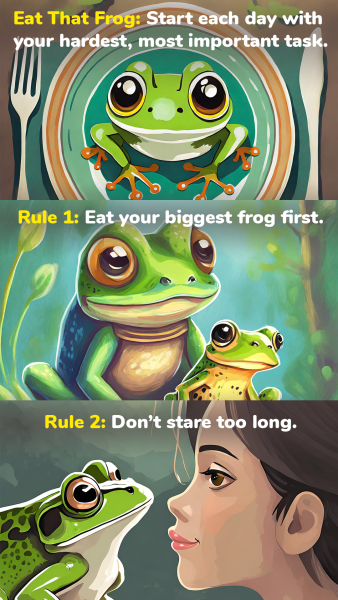
Main Concept – Eating Your Frog: The idea is straightforward: identify the hardest task of your day (your ‘frog’) and do it first thing in the morning. This approach ensures that you’ve tackled the most daunting part of your day early on, setting a productive tone for the rest of the day.
It’s inspired by Mark Twain’s saying, “Eat a live frog first thing in the morning and nothing worse will happen to you the rest of the day.”
How to Eat Your Frog – 2 Rules:
- Identify Your Frog: For each day, choose the most challenging and important task you could do. So if you have 2 frogs, pick the biggest and ugliest one first.
- Avoid Overthinking: Start working on it immediately. Because it does no good to stare at your ‘frog’ for a long time before eating it.
Related Tips:
- Make a habit of evaluating your tasks the night before.
- Cultivate discipline to resist the temptation of starting with easier tasks.
- Regularly reassess your ‘frogs’ to ensure they align with your long-term goals.
In Summary: The “Eat That Frog” strategy says to begin each day with a single-minded focus on completing on your #1 most critical task. This leads to a more productive and satisfying life, and is actually a superpower in the world of success and achievement.
Probably the top self-help book of all time is The 7 Habits of Highly Effective People by Stephen Covey. In that book, Habit #3 is “Put first things first.” That author recommends we spend 30 minutes every week setting aside time for what is most important.
Stephen Covey calls them Quadrant 2 activities: the important, yet non-urgent activities like nurturing relationships that most impact our long-term effectiveness and well-being. If we neglect to do this, then our schedule will be filled with trivial activities that simply appear to be urgent.
In the "Eat That Frog" strategy, the 'frog' represents the .
Most important task
Series of warm-up tasks
Most time-intensive work
An edible amphibian
✍️ 2. Setting Clear Goals: Gain clarity by writing down a daily action plan for reaching your goals
Why This Matters: Imagine setting off on a journey without Google Maps or Apple Maps. That’s what trying to achieve success without clear goals is like. In “Eat That Frog,” Brian Tracy emphasizes that high achievers start by setting clear, specific, and achievable goals. This step is not just important; it’s fundamental.
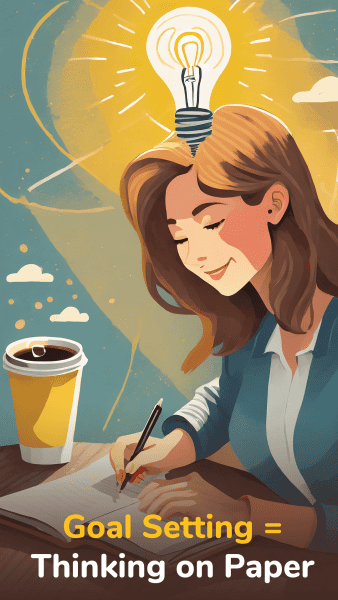
Main Concept – Goal Setting: The power of goal setting lies in its clarity. Writing down your goals is like plotting a destination on Google Maps. Each step you take is akin to following a turn-by-turn direction, bringing you closer to your desired destination. It transforms abstract dreams into concrete plans.
How to Implement Goal Setting:
- Decide what you want to achieve (e.g., a one-year goal).
- Write your goal down clearly. Brian Tracy says, “Think on paper.”
- Set a deadline, along with sub-deadlines.
- Outline a detailed list of tasks to achieve this goal.
- Prioritize these tasks and create an action plan.
- Start immediately, don’t delay.
- Act daily; do something every day that moves you closer to your goal.
The last step is most important: Do something daily that moves you closer to your goal.
Related Tips:
- Regularly review and adjust your goals.
- Break down larger goals into smaller, manageable tasks.
- Celebrate small victories to maintain motivation.
In Summary: Writing down clear goals forms the foundation of high productivity. With this strategy, you’re not just doing things randomly; you’re strategically conquering your most important goals step-by-step.
In the influential productivity book “Getting Things Done” by David Allen, a key idea is to write down a “Next Action Step” for every single project in our lives, both personal and professional.
For example, to make a to-do list more effective, don’t just write vague items like “bank” or “washing machine.” Think about what you need to do first, like discussing the budget for buying the new washing machine with your partner. Then write that down.
This approach turns your list into a set of clear, actionable steps, making it easier to get things done without feeling overwhelmed. It saves time and energy by deciding in advance what needs to be done.
In "Eat That Frog," the most crucial step for achieving your goals is to .
Plan thoroughly
Make lists
Act daily
Prioritize tasks
📈 3. The 80/20 Rule of Prioritization: Focus your efforts on tasks with the highest impact
Why This Matters: Ever felt like you’re just checking tasks off your list but not making real progress? Enter the 80/20 Rule, a game-changer in prioritization. It’s not just about doing more; it’s about doing what matters.

Understanding the 80/20 Rule: At its core, the 80/20 Rule says that 20% of your efforts yield 80% of your results. In other words, not all tasks are created equal. The trick is identifying which tasks fall into that critical 20% and giving them your full attention.
How to use the 80/20 Rule: Write down a list of 10 tasks you typically do, then circle the top 2 that drive the most significant impact.
Constantly ask yourself: Is this task in the top 20% that drives 80% of my results? If not, it can wait.
In this way, the 80/20 Rule simplifies decision-making at work, ensuring that you’re always tackling the most crucial tasks first. Remember, there’s never enough time to do everything, but there’s always time for the most important things.
Related Strategies:
- Key Result Areas: This means identifying where you can make the biggest difference. Rate your key job skills from 1 to 10, find your weak points, and work on them.
Often, what we procrastinate on is what we’re not good at. By improving your skills in key areas, you reduce procrastination and boost performance by eliminating your largest constraints. Brian Tracy recommends asking ourselves this question:
“What can I and only I do, that if done well, will make a real difference?” —Peter Drucker
- The Law of Three: This principle narrows your focus even further, suggesting that three key tasks typically contribute almost all the value in most occupations. Concentrate on these to maximize your productivity.
- Creative Procrastination: The art of deliberately delaying less critical tasks. It’s about finding smarter ways to handle low-impact activities, such as eliminating, automating, or delegating them.
In summary, mastering the 80/20 Rule, focusing on Key Result Areas, and other strategies of prioritization are essential for maximizing productivity. Not by working harder, but by working on what really matters to results.
Tim Ferriss, productivity expert and author of “The 4-Hour Workweek” and many other bestselling books, puts it like this: “Focus on being productive instead of busy.” “Being busy is a form of laziness – lazy thinking and indiscriminate action. Being busy is most often used as a guise for avoiding the few critically important but uncomfortable actions.”
Key Result Areas are about focusing on improving important skills in our weak points. It's about answer the question: ""
What everyone needs help with?
What can only you do?
What takes the most time?
What is easiest to complete?
🔭 4. Long-Term Perspective: Overcoming procrastination by aligning your daily decision-making with long-term goals
Why This Matters: Ever wondered what separates the successful from the rest? It’s not about being the smartest or having the best connections. Dr. Edward Banfield’s 50-year Harvard study uncovers a surprising answer: the secret sauce to success is a long-term perspective. But this isn’t what you might think…
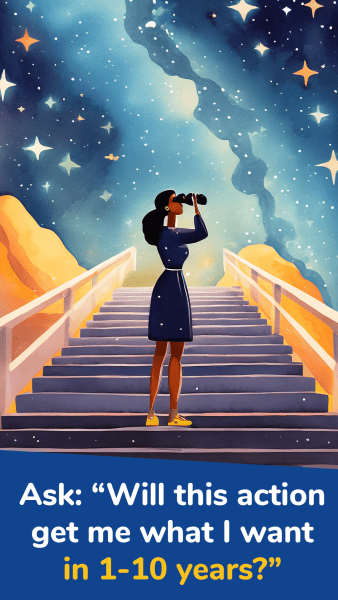
Understanding Long-Term Perspective: Banfield’s research highlights a crucial point: those who think long-term tend to make smarter decisions in the short term. They’re not just focused on immediate gratification or quick wins. Instead, they’re playing a longer, more strategic game. They think 5, 10, 20 years ahead.
This isn’t just about setting goals for the distant future; it’s about aligning your daily choices with those long-term goals. It’s a way to rise above immediate distractions and focus on what really matters.
How to Implement Long-Term Thinking:
- Define what truly matters to you. This clarity guides your daily decisions, helping you focus on what brings the long-term benefits you really want.
- Always consider the consequences before starting any task. Ask yourself: Will it bring me closer to my long-term goals? Successful individuals often delay short-term gratification for long-term rewards. It’s about making sacrifices now for a better future.
In Summary: Overcoming procrastination is closely tied to how you perceive time. Taking a long-term perspective is not just about future planning; it’s for better decision-making in the present. By aligning your daily actions with your long-term ambitions.
The “Growth Mindset,” introduced by psychologist Carol Dweck, helps us understand procrastination better. Sometimes, we put off tasks because we’re scared of failing or not being perfect. This is a “Fixed Mindset,” where we think our abilities are set and judge ourselves based on our performance. In contrast, a “Growth Mindset” means seeing every effort as a chance to learn and grow. It’s a more long-term view. With this mindset, even failures are opportunities to improve, not something that makes us feel bad about ourselves.
Read more in our summary of Mindset by Carol Dweck (coming soon)
According to Harvard research, what predicts success better than education or intelligence?
Networking skills
Financial background
Technical know-how
Long-term perspective
📅 5. The 10/90 Planning Rule: Spend a small amount of time in daily planning to save a lot in execution.
Why This Matters: Feeling overwhelmed by endless tasks? Brian Tracy’s 10/90 rule in daily planning can be a game-changer. It’s about making your work time more organized, streamlined, and efficient.

Main Concept – The 10/90 Rule: The 10/90 rule states that spending 10% of your time planning can save 90% in execution. For instance, investing just 15 minutes in planning your day can save up to 2.5 hours of work time. This approach ensures you’re working on what matters, not just keeping busy.
How to Implement Daily Planning:
- Create a Daily List the Night Before: This helps you start each morning focused and clear on what you should work on, rather than wasting time and mental energy on decision-making.
- Use Different Lists: Maintain a master list for big goals and break it down into monthly, weekly, and daily tasks.
- Check Off Completed Tasks: As you finish tasks, tick them off your list. The sense of satisfaction you get is your brain rewarding you with a hit of dopamine, keeping you motivated to do more.
As you write and revise your plans, always keep in mind the military principle known as The 6 P’s: Proper Prior Planning Prevents Poor Performance.
In Summary: Mastering daily planning through the 10/90 rule and list-making helps focus your efforts on what truly matters. It’s a strategic approach to work that saves time and boosts efficiency.
According to Brian Tracy, what is the key benefit of creating a daily list the night before?
Increased relaxation
Better execution
Enhanced sleep
Morning focus
✅ 6. One Step at a Time: Break down overwhelming tasks into small, manageable steps
Why This Matters: Do you have a big project that you want to do, but feel totally overwhelmed just thinking about it? For example, building a website, starting a business, or learning guitar. These are all complex projects that can take months, so it can feel really easy to procrastinate on doing anything, even if we really want to.
Main Concept – Small Steps: Divide your large task into small, actionable steps. Overcoming procrastination often requires breaking down intimidating goals into actionable ‘baby steps’ that you can actually complete in one sitting. It’s about turning a difficult project into a series of small tasks that actually feel achievable. Then focus solely on completing the next one step in front of you. Then another. Then another. Pretty soon, you’re done!
How to Implement Small Steps:
- Salami Slice Technique: Imagine you need to eat a roll of salami. How would you do that? One thin slice at a time. In the same way, divide any project you’re working on into a hundred tiny slices, then just work on ‘eating’ the next slice. This strategy is captured in the expression: “How do you eat an elephant? One bite at a time.”
- Swiss Cheese Technique: Much like poking holes in a block of Swiss cheese, this technique involves tackling small portions of a larger task whenever you have a few spare minutes. This is great for those jobs that you find more unpleasant. By gradually ‘poking holes’ in the task, you’ll soon find that you’ve made significant progress without the need to dedicate long periods to it.
Related Concepts:
- Flow State: By focusing on small steps, you can enter a mental state called ‘flow’, where you become fully immersed and efficiently work on the task at hand.
- Tiny Daily Targets: For example, writing one page a day can eventually lead to a completed book without the pressure of the end goal.
In Summary: Taking one step at a time is about simplifying large tasks into smaller actions, making it easier to start and maintain momentum. This approach is key to overcoming procrastination and gradually achieving your larger goals.
One of my favorite stories ever that illustrates this idea so well comes from Will Smith, the superstar Hollywood actor. When Will Smith was 11 years old, his father made him build a large brick wall for a year. The project felt impossible, but he eventually got it done.
That experience taught Will the most valuable lesson ever for success in his career – To accomplish anything, forget about your overwhelming long-term goal (the wall), and instead focus on the ONE next doable action (the brick).
In overcoming procrastination on large projects, an effective strategy is to break them down into .
Individual objectives
Weekly milestones
Strategic task items
Small actionable steps
🏷️ 7. The ABCDE Method: Categorize and prioritize each task by importance for optimal productivity
Why This Matters: In a world where everyone’s to-do list is overflowing, knowing how to prioritize effectively is key. With the ABCDE Method, Brian Tracy gives us a straightforward way to organize our tasks based on importance and urgency, making sure that we focus on what truly matters.
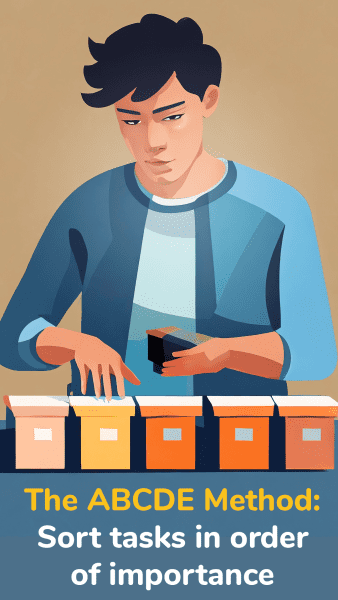
Main Concept – The ABCDE Method: This method involves categorizing each task on your list with an A, B, C, D, or E, based on its importance and urgency.
- A (Must do): Critical tasks with significant consequences for completion or neglect.
- B (Should do): Important tasks but with lesser consequences than ‘A’ tasks.
- C (Nice to do): Tasks that are beneficial but not essential.
- D (Delegate): Tasks that can be handed off to someone else.
- E (Eliminate): Tasks that can be removed with no impact.
How to Implement This Concept:
- List Everything: Write down all tasks for the day.
- Categorize: Assign each task an A, B, C, D, or E.
- Prioritize: Always complete ‘A’ tasks before moving to ‘B’ tasks, and so on.
- Delegate or Eliminate: Pass on ‘D’ tasks and strike off ‘E’ tasks.
In Summary: The ABCDE Method is a simple yet powerful tool for prioritizing all tasks in 5 specific categories from A to E. This helps us make sure that we’re always working on tasks that drive the most value and impact.
In the ABCDE Method, if you have both 'A' and 'B' tasks on your list, you should ALWAYS start with .
'B' tasks
'C' tasks
'A' tasks
'D' tasks
💻 8. Leveraging Technology: Mastering digital tools for increased productivity and focus
Why This Matters: In our digitally-driven world, technology can be both a blessing and a curse for productivity. Learning how to use technology effectively without falling prey to its distractions is crucial for maintaining focus and enhancing work efficiency.
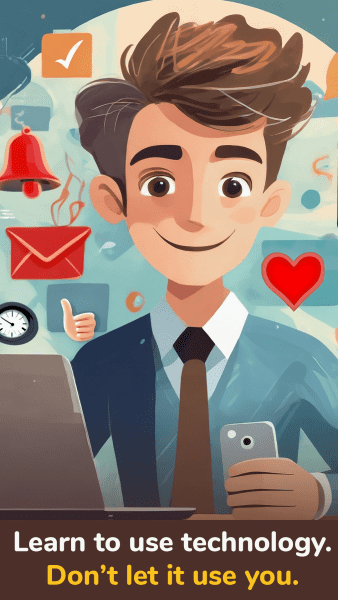
Main Concept – Technology as a Tool, Not a Distraction: The key to leveraging technology for productivity lies in using it as a servant, not as a master. It’s about being intentional with your use of technology, ensuring it aids rather than hinders your work. Balancing its benefits while avoiding the pitfalls of constant connectivity is essential.
Actionable Tips:
- Use Devices Mindfully: Resist the urge to check devices first thing in the morning. If possible, check notifications and email at specific times, not impulsively throughout the day.
- Regular Rejuvenation: Schedule regular breaks to detach from technology, like taking one full day off each week from all work-related technology.
- Dedicated Time Blocks: Allocate large chunks of time (30, 60, 90 minutes) for focused work, treating these as appointments with yourself.
- Single-Tasking: Focus on one task at a time, avoiding multitasking. Brian Tracy says we can reduce time needed to complete a task by 50% with concentrated singular focus.
In Summary: Leveraging technology is using it as a tool to help us get more done with less effort, while avoiding its potential to distract. By being mindful about our technology devices and scheduling specific times for focused work.
Cal Newport, a well-known productivity writer and computer science professor, discusses in his book “Deep Work” the importance of focusing deeply. He says the most highly productive and intelligent people he knows dedicate long, uninterrupted blocks of time to their work or study.
Newport emphasizes, “To learn hard things quickly, you must focus intensely without distraction.” This approach is about minimizing interruptions to achieve more in less time.
To increase productivity with technology, it's recommended to upon waking up.
Start working immediately
Avoid checking devices
Respond to emails
Check all devices
- Identify Your ‘Frog’: Choose the most challenging task each morning and complete it first.
- Write Daily Goals: List your daily objectives every night for what you will accomplish tomorrow, ensuring each item is specific and achievable.
- Prioritize High-Impact Tasks: Apply the 80/20 rule by writing down all the tasks you do in a given day, circling the top 20% that give significant results, and allocating more time towards those.
- Align Daily Actions with Long-Term Goals: For each task, ask how it contributes to your long-term goals. If it doesn’t have much impact, consider delaying or delegating it.
- Dedicate Time to Plan: Spend the first 10% of your day (or about 15-30 minutes) planning your tasks.
- Break Down Large Projects: For large or overwhelming projects, break them into smaller steps. Then focus on completing them one at a time.
- Use the ABCDE Method: Categorize each task as A (must do), B (should do), C (nice to do), D (delegate), or E (eliminate). Then start with the A tasks and work your way through the list.
- Utilize Technology Effectively: Set specific times for checking emails and messages to avoid constant distractions.


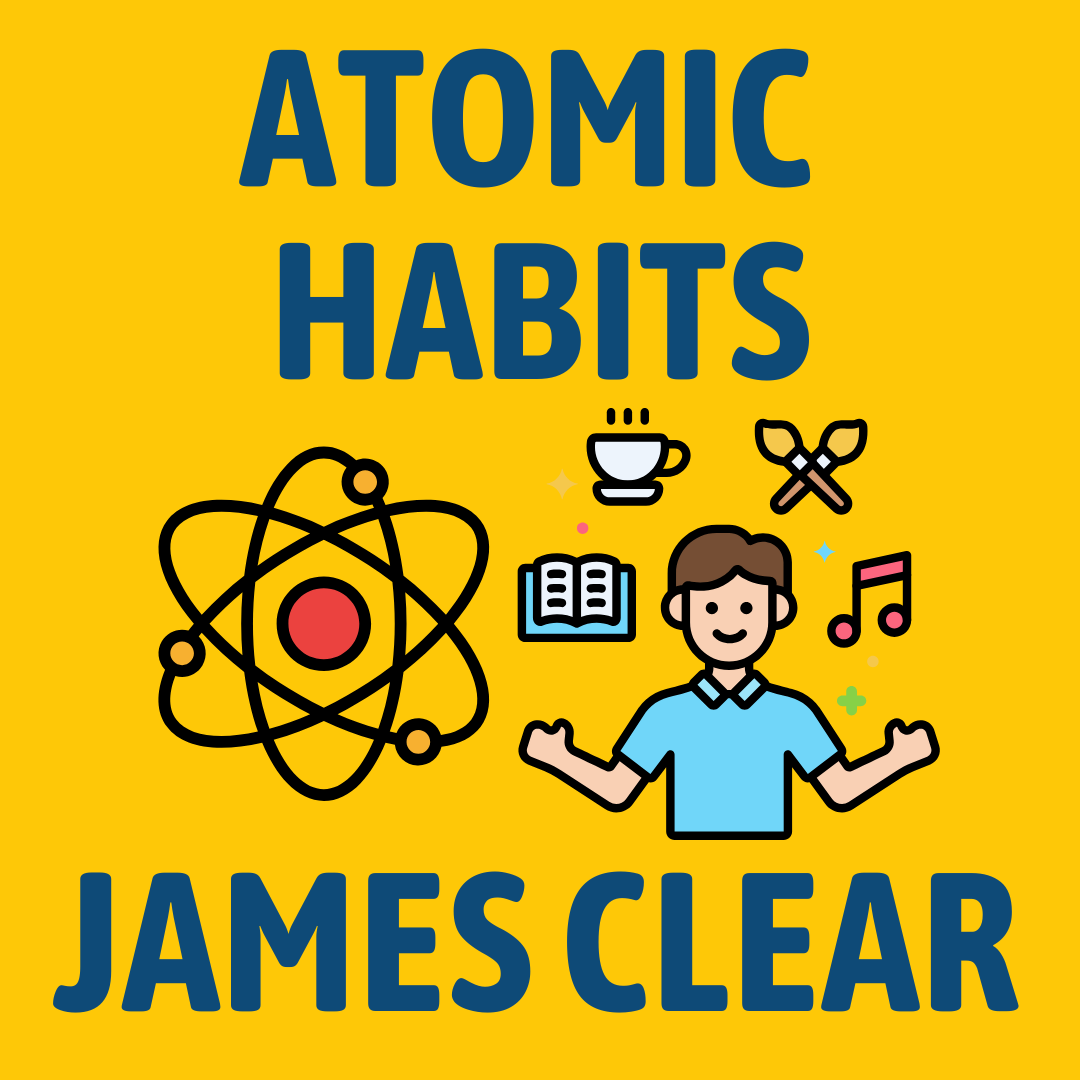
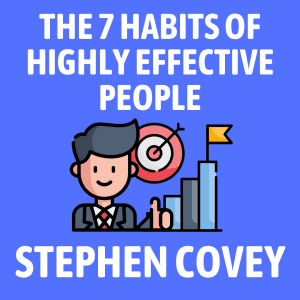

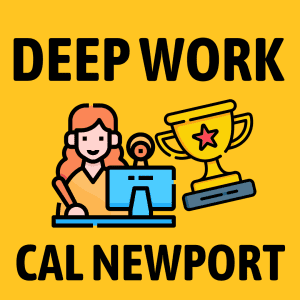



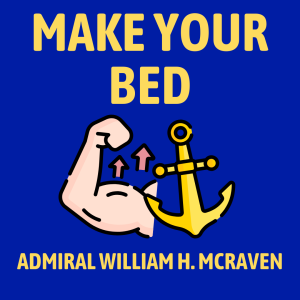
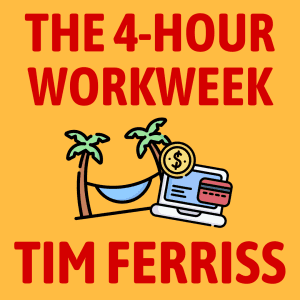
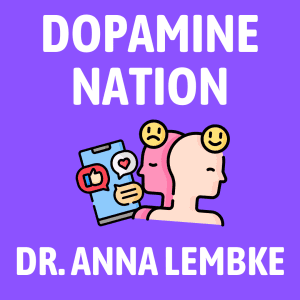

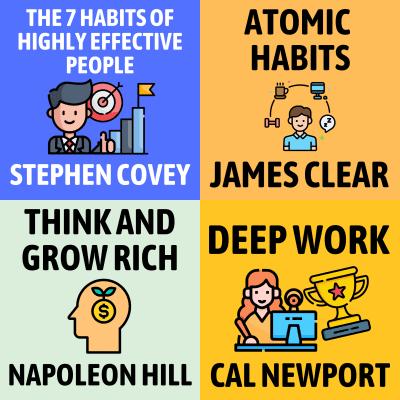
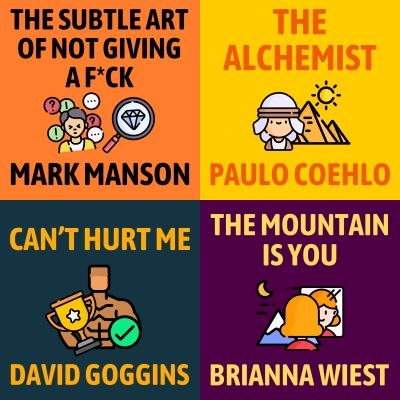

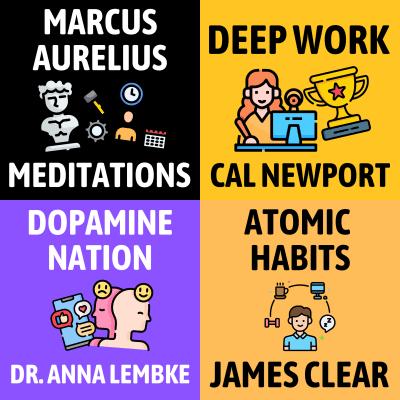

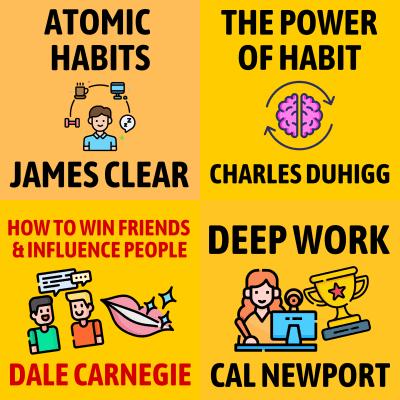
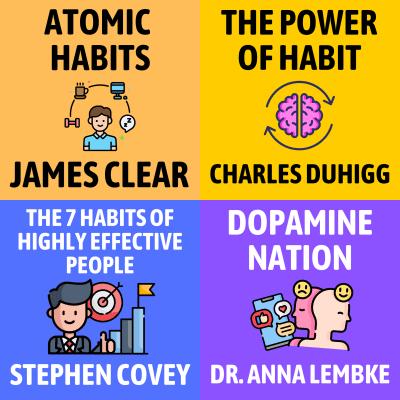

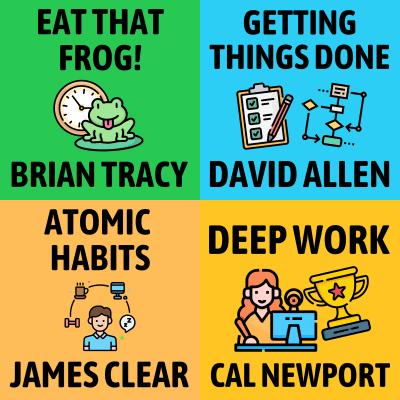
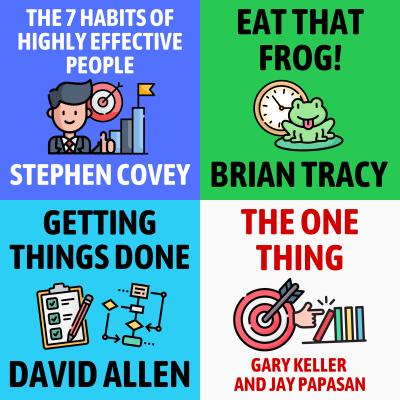











Community Notes